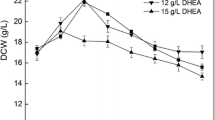Abstract
This study investigated the effects of hydroxylase cyptochrome P450 inducers on the efficiency of the biotransformation of dehydroepiandrosterone (DHEA) to 3β, 7α, 15α-trihydroxy-5-androsten-17-one (7α,15α-diOHDHEA) by Colletotrichum lini ST-1. Special attention was given to the substrate DHEA being the best inducer and the fact that it could improve the yield of 7α, 15α-diOHDHEA. Based on the effects of the DHEA pre-induction phases and additional concentrations on 7α, 15α-diOHDHEA production, a substrate pre-induction process was established as follows: 2 g/L DHEA was added for the first time after 12 h of inoculation, followed by the second addition of 6 g/L DHEA after 12 h later. The results showed that this substrate pre-induction process improved the content of cytochrome P450 and that the 7α, 15α-diOH-DHEA yield reached 90.1%, which was 26.9% higher than that obtained in the original process.
Similar content being viewed by others
References
Donova, M. V. and O. V. Egorova (2012) Microbial steroid transformations: Current state and prospects. Appl. Microbiol. Biotechnol. 94: 1423–1447.
Pollard, D. J. and M. J. Woodley (2006) Biocatalysis for pharmaceutical intermediates: The future is now. Trends Biotechnol. 25: 66–73.
Mahato, S. B. and S. Garai (1997) Advances in microbial steroid biotransformation. Steroids 62: 332–345.
Marques, M. P. C., F. Carvalho, C. C. C. R. de Carvalho, J. M. S. Cabral, and P. Femandes (2010) Steroid bioconversion: Towards green processes. Food Bioprod. Proc. 88:12–20.
Kolek, T., N. Milecka, A. Swizdor, A. Panek, and A. Bialonska (2011) Hydroxylation of DHEA, androstenediol and epiandrosterone by Mortierella isabellina AM212. Evidence indicating that both constitutive and inducible hydroxylases catalyze 7α-as well as 7β-hydroxylations of 5-ene substrates. Org. Biomol. Chem. 9: 5414–5422.
Lobastova, T. G., S. A. Gulevskaya1, G. V. Sukhodolskaya1, K. F. Turchin, and M. V. Donova1 (2007) Screening of mycelial fungi for 7α- and 7β-hydroxylase activity towards dehydroepiandrosterone. Biocatal. Biotransform. 25: 434–442.
Romano, A., D. Romano, E. Ragg, F. Costantino, L. Roberto, R. Gandolfid, and F. Molinari (2006) Steroid hydroxylations with Botryodiplodia malorum and Colletotrichum lini. Steroids 71: 429–434.
Bernhardt, R. (2006) Cytochromes P450 as versatile biocatalysts. J. Biotechnol. 24: 128–145.
Andriushina, V. G., A. V. Druzhinina, V. V. Iaderets, T. S. Stytsenko, and N. E. Voishvillo (2010) 7α-Hydroxylation of steroid 5α-olefins by mold fungi. Appl. Biochem. Microbiol. 46: 69–74.
Mutafov, S., B. Angelova, T. Avramova, L. Boyadjieva, and I. Dimova (1997) The inducibility of 9α-steroid hydroxylating activity in resting Rhodococcus sp. cells. Proc. Biochem. 32: 585–589.
Carballeira, J. D., M. A. Quezada, P. Hoyos, Y. Simeo, M. J. Hernaiz, A. R. Alcantara, and J. V. Sinisterra (2009) Microbial cells as catalysts for stereo selective redox reactions. Biotechnol. Adv. 27:686–714.
Ahmed, E. M. (2007) Production of 11α-hydroxyprogesterone using Aspergillus terreus immobilized on polytetrafluoroethylene. Braz. J. Microbiol. 38: 224–229.
Shen, Y. J., H. Sun, Y. W. Fu, C. Y. Xu, and M. Wang (2012) Progesterone hydroxylation with Colletotrichum lini AS3. 4486. Adv. Mat. Res. 343–344: 1070–1073.
Smith, K. E., F. Ahmed, R. A. Williams, and S. L. Kelly (1994) Microbial transformations of steroids-VIII. Transformation of progesterone by whole cells and microsomes of Aspergillus fumigatus. J. Steroid Biochem. Mol. Biol. 49: 93–100.
Lu, W. Y., L. X. Du, M. Wang, J. P. Wen, B. Sun, and Y. W. Guo (2006) Effect of two-steps substrate addition on steroids 11α-hydroxylation by Curvularia lunata CL-114. Biochem. Eng. J. 32: 233–238.
Andryushina, V. A., A. V. Druzhinina, V. V. Yaderets, T. S. Stytsenko, and N. E. Voishvillo (2011) Hydroxylation of steroids by Curvularia lunata mycelium in the presence of methyl-β-cyclodextrine. Appl. Biochem. Microbiol. 47: 42–48.
Chen, K. C. and H. C. Wey (1990) 11β-Hydroxylation of coxtexolone by Curvularia lunata. Enz. Microb. Technol. 12: 305–308.
Author information
Authors and Affiliations
Corresponding author
Additional information
These authors had equal contributions to this work.
Rights and permissions
About this article
Cite this article
Li, H., Fu, Z., Li, H. et al. Improvement of the steroid dihydroxylation efficiency from dehydroepiandrosterone using a substrate pre-induction biotransformation process. Biotechnol Bioproc E 18, 486–490 (2013). https://doi.org/10.1007/s12257-012-0828-1
Received:
Revised:
Accepted:
Published:
Issue Date:
DOI: https://doi.org/10.1007/s12257-012-0828-1




